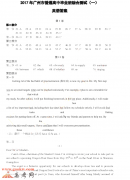河北省衡水中学2014届高三上学期三调考试英语试题答案(5)
The findings provided by these eye-trackers suggest that babies may be more capable of understanding and acting on what they see than had been thought. “Quick looks at their mothers’ faces may be all they need to get the information they want. They seem to be surprisingly efficient,” said John Franchak who studies psychology at New York University.
Although sight might largely seem effortless to us, in reality we actively choose what we look at, making about two to four eye movements every second for some 150,000 motions (运动) daily, said Karen Adolph, also a developmental psychologist at N.Y.U. “Sight is not passive,” she said. “We actively adjust our eye movements to the motions of our hands and bodies.”
Eye-tracking studies have existed for more than a century, but the instruments involved were typically desk machines. The wearable eye-trackers that Dr. Adolph, Mr. Franchak and their colleagues use are based on equipment developed over the last decade by Positive Science, a New York company, with money from the United States Naval Research Laboratory. They were designed to help scientists. Eye-trackers are currently being used in studies to learn the differences in how amateur and professional geologists (地质学家) scan landscapes and how people examine signs when looking for exits during emergencies.
The researchers also found that during the studies babies looked at their mothers just 16 percent of the time. “That is lower than expected.” Dr. Adolph said. A large body of past research has placed importance on children watching the faces of adults as they name objects to learn languages. These findings suggest children may not have to look very long to get the information they need, either from people or objects. This gives a new understanding of how much information they need, or how quickly children might process the information.
67. How do babies get the information they need?
A. By using their own language. B. By looking at their mothers’ eyes.
C. By watching their mothers’ facial expression. D. By listening to others.
68. The underlined word “They” in Paragraph 5 refers to__________
A. eye-tracking studies B. original devices
C. eye-trackers D. desk machines
69. What does Dr. Adolph think of the result of the research?
A. Exciting. B. Unacceptable. C. Strange. D. Surprising.
70. The text is most probably taken from__________.
A. a website about relationship between mothers and children
B. a science magazine about children’s actions
C. a book about how to teach children
D. a newspaper about processing information
E
第二节:根据短文内容,从短文后的选项中选出能填入空白处的最佳选项,选项中有两项为多余选项。(71—75涂到答题卡上,选E涂AB,选F涂AC,选G涂AD)
I used to be a thin little kid who was always the shortest and sickest in my class. I wasn’t very athletically involved during my childhood.
When I entered middle school, a lot of my friends were signing up for the school’s sports teams. 71 On the first day of tryouts(选拔赛)for the soccer team, the coach told us to run laps for warm-up. As I struggled to keep up with the team, I found myself falling farther and farther behind until I was the last one to finish. 72
I was disappointed, but at the same time, I knew I had to do something about my health and fitness. 73 People thought I was crazy because I ran a slow 11-minute mile in the gym class, but I was determined to get into shape and improve my mile time.
74 It was a lot of running for me, but I kept on practicing day after day. As the season progressed, I found that I could run longer and faster.
Eighth grade soon rolled around and I was feeling really confident about trying out for another sports meet. Instead of attempting soccer a second time, I decided to give field hockey a try. 75 This time, I was well prepared. After a week of tryouts, I was ecstatic(狂喜的)to see that my name made it on the list.
I was inspired, and I learned an important lesson: Once you do get into shape, don’t stop or give up!
A. Again, the coach instructed us to run a lot of laps.
B. After tryouts were over, my name never made it on the list.
C. I made a big decision to sign up for the track and field team.
D. Being in shape helped me feel energized, flexible, and strong.
E. Fortunately, I wasn’t the only slow runner trying to get into shape.
F. The first day of practice was one of the hardest workouts I’ve ever had.
G. One of my friends convinced me to try out for the soccer team with her and I agreed.
第二卷(共35分)
(二卷在答题纸上答题)
第一节:短文改错(共10小题,每小题1分,满分10分)
英语课上,老师要求同桌同学相互修改作文。假设以下短文为你同桌所写,请你对其进行修改。文中共有10处错误,每句中最多有两处。错误涉及一个单词的增加、删除或修改。
增加:在缺词处加一个漏词符号∧,并在此符号下面写出该加的词。
删除:把多余的词用斜线\划掉。
修改:在错词下面划一横线,并在该词下面写出修改后的词。
注意:1、每处错误及其修改均仅限一词;
2、只允许修改10处,多者从第11处不计分。
 themselves in their everyday life, feel lonely and homesick. Clothes, money or mobile phone are sometimes gone. And because of different climates and the food, they often feel sick. Some even rented rooms outside the campus, but I don’t think it’s so safely. Could you tell me how to deal with these problems so that I will be able to get used the university life in the future?
themselves in their everyday life, feel lonely and homesick. Clothes, money or mobile phone are sometimes gone. And because of different climates and the food, they often feel sick. Some even rented rooms outside the campus, but I don’t think it’s so safely. Could you tell me how to deal with these problems so that I will be able to get used the university life in the future?



